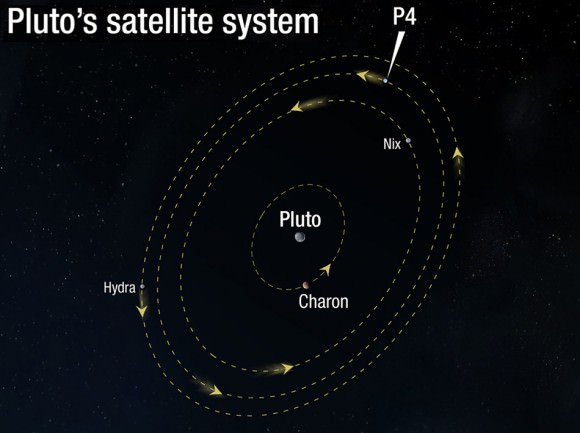
Pluto's newest found moon, P4, orbits between Nix and Hydra, both of which orbit beyond Charon. Could there be still more moons of Pluto? Perhaps, and the New Horizons team plans to look harder to ensure that we don't run into something that could damage or destroy New Horizons. Credit: NASA
With nearly two-thirds of its journey complete, the New Horizons spacecraft is still alive and well. It recently experienced a “hibernation wakeup” which started on November 5th and will last until November 15th… and it will sleep again until a month-long call in January. However, the real “wakeup call” may be when it reaches the complicated Pluto system. Watch out for that rock!
As more and more moons are discovered around Pluto, the higher the probability becomes of one of them – or debris surrounding them – could impact the delicate probe. With P4 discovered just a few short months ago, scientists are beginning to wonder just how many more are there which are too small and faint to be seen.
Says New Horizons Principal Investigator Alan Stern: “Even more worrisome than the possibility of many small moons themselves is the concern that these moons will generate debris rings, or even 3-D debris clouds around Pluto that could pose an impact hazard to New Horizons as it flies through the system at high speed. After all, at our 14-kilometer-per-second flyby speed, even particles less than a milligram can penetrate our micrometeoroid blankets and do a lot of damage to electronics, fuel lines and sensors.”
To enable research into what might be a prospective problem, the New Horizons team brought together about 20 of the world’s experts in ring systems, orbital dynamics and state-of-the-art astronomical observing techniques to search for small satellites and rings at distant Pluto. During a two day workshop, the group hashed and rehashed every possible scenario – including all the hazards that a small moon and debris-strewn system might cause.

The presenters and attendees of the New Horizons Pluto Encounter Hazards Workshop on November 4, 2011. Credit: NASA
“We found a plausible chance that New Horizons might face real danger of a killer impact; and that to mitigate that hazard, we need to undertake two broad classes of work.” said Stern. “First, we need to look harder at the Pluto system for still undiscovered satellites and rings. The best tools for this are going to be the Hubble Space Telescope, some very large ground-based telescopes, telescopes that can make stellar occultation observations of the space between Pluto and Charon where New Horizons is currently targeted, and thermal observations of the system by the ALMA radio telescope array just now being commissioned.”
The next step is planning – planning on a possible safer route through the Pluto system in the event that observations confirm navigational hazards. Studies presented at the Encounter Hazards Workshop show a good “safe haven bailout trajectory” (or SHBOT) could be designed to target a closest-approach aim point about 10,000 kilometers farther than the nominal mission trajectory. In this case, it would be a matter of aiming more towards Charon’s orbit, where the moon itself has cleared a path. However, even 180 degrees away on closest approach may not be enough. There’s always a chance of a debris field – one that doesn’t follow a plane, but has created a torus. In this event, material could be sailing along at speeds of up to 1-2 kilometers per second. Enough to annihilate delicate instruments.
“The question of whether the Pluto system could be hazardous to New Horizons remains open –but one we’ll be studying hard over the next year, with everything from computer models to big ground-based telescopes to the Hubble.” concludes Stern. “I’ll report on results as we obtain them, but it is not lost on us that there is a certain irony that the very object of our long-held scientific interest and affection may, after so many years of work to reach her, turn out to be less hospitable than other planets have been. We’ll see.”
Source: Universe Today
No hay comentarios:
Publicar un comentario